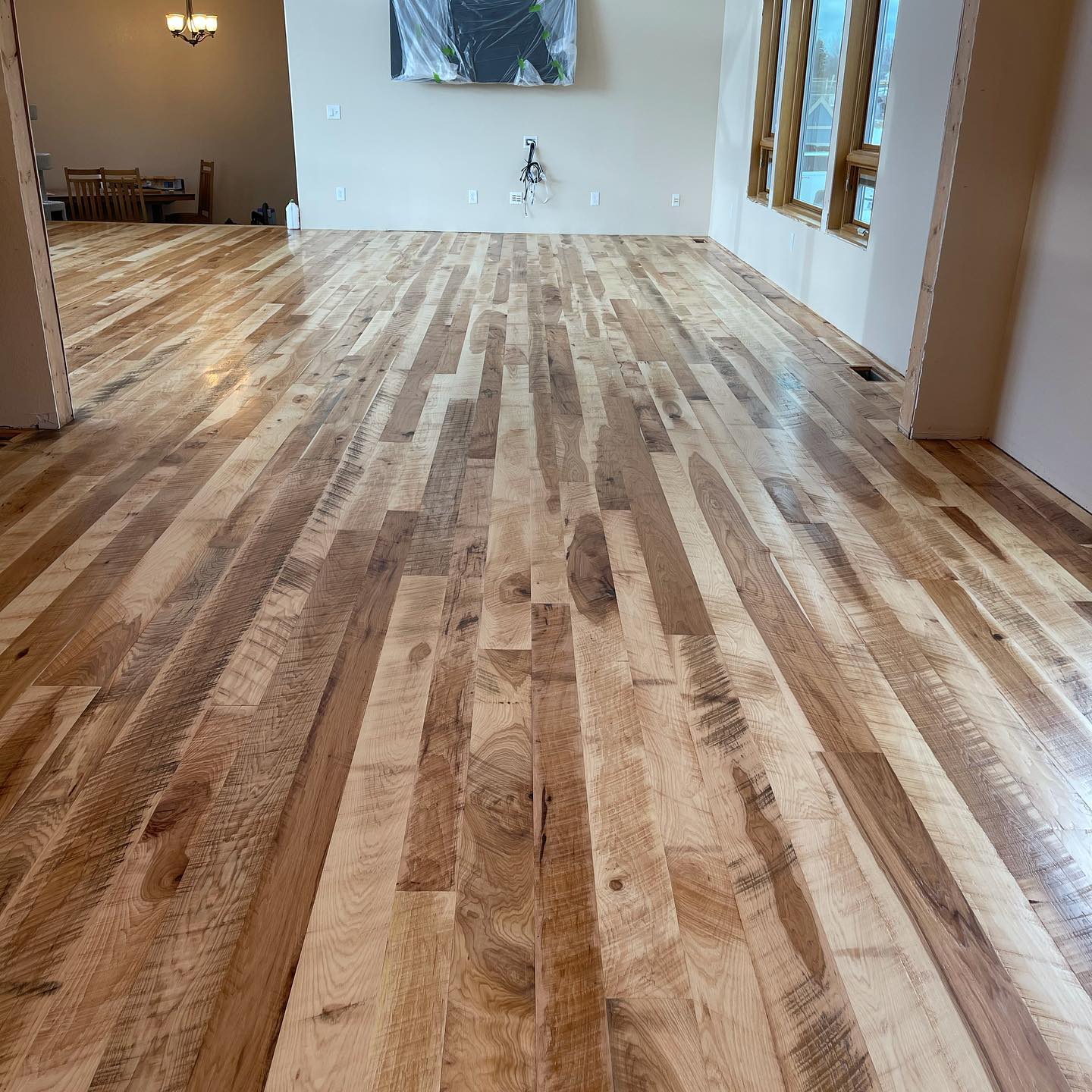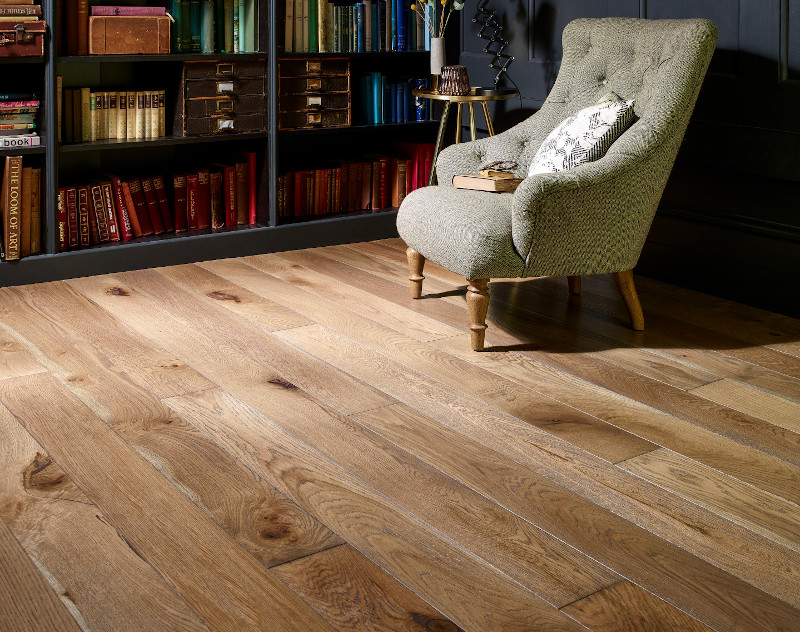When deciding between hickory and oak flooring, consider your priorities. Hickory is renowned for its exceptional hardness and rustic aesthetics, ideal for high-traffic areas. On the other hand, oak offers timeless appeal and versatility, fitting various design styles. While hickory tends to be pricier, its durability may lead to long-term cost savings. Ultimately, the choice depends on your preferences, budget, and the specific demands of your living space.
Characteristics of Hickory Flooring
Overview of Hickory Wood: Hickory is a dense and durable hardwood known for its strength and resilience. It is often used in flooring due to its exceptional hardness, making it an ideal choice for high-traffic areas.
Hardness and Durability: Hickory ranks high on the Janka hardness scale, indicating its resistance to wear and denting. This makes it an excellent choice for households with children, pets, or heavy foot traffic.
Grain Patterns and Color Variations: Hickory boasts a distinctive grain pattern with variations in color, ranging from light tones to deep browns. This natural variation adds visual interest and rustic charm to spaces.
Resistance to Wear and Tear: Hickory’s natural hardness contributes to its resistance to wear and tear. It can withstand the impact of dropped objects and heavy furniture, making it a long-lasting flooring option.
Suitable Environments for Hickory Flooring: Hickory flooring is well-suited for various environments, including kitchens, living rooms, and hallways. Its durability makes it an excellent choice for areas prone to high levels of activity.

Characteristics of Oak Flooring
Overview of Oak Wood: Oak is a classic and versatile hardwood known for its timeless appeal. It comes in two main varieties: red oak and white oak, each with its unique characteristics.
Hardness and Durability: Oak is also a durable hardwood, though it is generally slightly softer than hickory. Red oak tends to be softer than white oak, making white oak a preferable option for spaces with heavier traffic.
Grain Patterns and Color Variations: Oak exhibits prominent grain patterns with color variations, ranging from pale whites to rich reds. Its versatile appearance complements a wide range of interior design styles.
Resistance to Wear and Tear: While not as hard as hickory, oak is still a durable flooring option that can withstand daily wear and tear. It is suitable for most residential spaces and holds up well over time.
Suitable Environments for Oak Flooring: Oak flooring is versatile and adaptable, making it suitable for various environments. It is a popular choice for living rooms, bedrooms, and dining areas.

Hardness
Hickory and oak are both renowned for their durability and strength, with each boasting impressive hardness ratings on the Janka scale, a measure of a wood’s resistance to wear and denting.
Hickory typically ranks higher on the Janka scale compared to oak, making it one of the hardest domestic hardwoods available for flooring. Hickory’s Janka hardness rating ranges from approximately 1820 to 2200 pounds-force (lbf), depending on the species and variety.
This exceptional hardness makes hickory flooring highly resistant to scratches, dents, and other forms of wear, making it an excellent choice for high-traffic areas.
On the other hand, oak also offers considerable hardness, with red oak averaging around 1290 lbf and white oak averaging slightly higher, around 1360 lbf. While oak may not match the hardness of hickory, it still provides robust durability and is suitable for a wide range of residential and commercial applications.
Cost
On average, hickory flooring can cost anywhere from $3 to $8 per square foot for materials only. However, premium grades or specialty finishes can drive the price higher.
Installation costs for hickory flooring typically range from $3 to $8 per square foot, depending on factors like subfloor condition and the complexity of the installation. However, prices can vary significantly based on location and the specific installer.
Red oak is usually less expensive than white oak, with prices averaging between $2 to $6 per square foot for materials only. White oak tends to be slightly more expensive, ranging from $3 to $7 per square foot.
Installation costs for oak flooring are similar to those for hickory and typically range from $3 to $8 per square foot. Again, this can vary based on factors like location and the complexity of the installation.
Installation
Nail-down installation is a preferred method for both hickory and oak flooring due to their durability and stability. These hardwoods, especially when in solid form, can withstand the force of nails or staples without compromising their integrity. The dense nature of hickory and oak makes them suitable for nail-down installation, ensuring a secure and long-lasting floor.
Floating installation can also be used for both hickory and oak flooring, especially in engineered hardwood formats. Engineered hickory and oak planks with click-lock systems are well-suited for floating installation, as they can be installed quickly and easily without the need for nails or adhesive. This method is particularly advantageous for DIY enthusiasts or for installations over existing floors, as it requires minimal subfloor preparation.
Maintenance
Cleaning hardwood floors, whether they’re made of hickory or oak, requires a gentle touch to preserve their natural beauty and integrity.
Sweep or vacuum the floor regularly to remove dust, dirt, and debris. Use a soft-bristle broom or a vacuum cleaner with a hardwood floor attachment to prevent scratching the surface. Place doormats at entry points to trap dirt and prevent it from being tracked onto the hardwood floors.
Use a well-wrung damp mop to clean the hardwood floors. Avoid using excess water, as standing water can damage the wood.
Choose a pH-neutral hardwood floor cleaner or a solution of mild dish soap and water for damp mopping. Avoid using harsh chemicals or abrasive cleaners, as they can strip the finish or damage the wood.
If using a commercial hardwood floor cleaner, follow the manufacturer’s instructions for dilution and application.
Place felt pads on the legs of furniture to prevent scratches and dents when moving or rearranging furniture. Use rugs or mats in high-traffic areas to reduce wear and tear on the hardwood floors.
Environmental Considerations
Both hickory and oak are considered sustainable hardwood options. Ensure that the wood is sourced from responsibly managed forests by looking for certifications such as FSC (Forest Stewardship Council).
Check for certifications that indicate eco-friendly practices in the production of hickory and oak flooring. This ensures that the wood is harvested and processed in an environmentally responsible manner.
Consider the environmental impact of transportation when comparing hickory and oak. Choosing locally sourced wood can help reduce the carbon footprint associated with the transportation of materials.
Final Thoughts
In conclusion, the choice between hickory and oak flooring ultimately depends on your specific needs, preferences, and budget. Both options offer unique characteristics, and understanding the differences will guide you toward making the right decision for your home.
Read More
Is white oak more expensive than oak?





